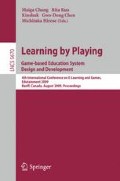Abstract
The ELEIN system reached two important issues for e-Learning: the presence of virtual tutors and the importance of emotions in the learning process. In this research we deal with the presence by means of using an expressive 3D animated avatar. Regarding the emotions in the learning process, we differentiate between static and dynamic generation of emotions. In the paper, we specially detailed the development of the dynamic generation, which is achieved by means of the implementation of a computational emotional model based on the cognitive perspective.
Access this chapter
Tax calculation will be finalised at checkout
Purchases are for personal use only
Preview
Unable to display preview. Download preview PDF.
References
Picard, R.: Affective Computing. MIT Press, Cambridge (1997)
Mehrabian, A.: Communication without words. Psychology Today 2(4), 53–56 (1968)
Hernandez, Y., Noguez, J., Sucar, E., Arroyo-Figueroa, G.: Incorporating an affective model to an intelligent tutor for mobile robotics. In: Frontiers in Education Conference, 36th Annual (October 2006)
Nass, C., Steuer, J., Tauber, E.R.: Computers are social actors. In: CHI 1994: Proceedings of the SIGCHI conference on Human factors in computing systems, pp. 72–78. ACM Press, New York (1994)
Prendinger, H., Ma, C., Yingzi, J., Nakasone, A., Ishizuka, M.: Understanding the effect of life-like interface agents through users’ eye movements. In: ICMI 2005: Proceedings of the 7th international conference on Multimodal interfaces, pp. 108–115. ACM Press, New York (2005)
Koda, T., Maes, P.: Agents with faces: The effects of personification of agents. In: 5th IEEE International Workshop on Robot and Human Communication, Tsukuba, Japan (November 1996)
Kim, Y.: Pedagogical agents as learning companions: the effects of agent affect and gender on student learning, interest, self-efficacy, and agent persona. PhD thesis, Department of Educational Psychology and Learning Systems. Florida State University, Tallahassee, FL, USA. Major Professor-Amy L. Baylor (2004)
Hongpaisanwiwat, C., Lewis, M.: Attentional effect of animated character. In: INTERACT (2003)
Nijholt, A.: Agents, believability and embodiment in advanced learning environments: Introduction to a panel discussion, 457 (2001)
Nkambou, R.: A framework for affective intelligent tutoring systems. In: Information Technology Based Higher Education and Training, July 10-13, pp. nil2–nil8 (2006)
Okonkwo, C., Vassileva, J.: Affective pedagogical agents and user persuasion. In: Stephanidis, C. (ed.) Universal Access in Human - Computer Interaction (UAHCI), New Orleans, USA, pp. 397–401 (2001)
Carretero, M., Oyarzun, D., Ortiz, A., Aizpurua, I., Posada, J.: Virtual characters facial and body animation through the edition and interpretation of mark-up languages. Computer & Graphics 29(2), 189–194 (2005)
Marriot, A.: Vhml: Virtual human markup language. In: OZCHI, Fremantle, Western Australia (November 2001)
RRL: The neca rrl (2006), http://www.ai.univie.ac.at/NECA/RRL/
Sloman, A.: Emotions in humans and artifacts. In: How many separately evolved emotional beasties live within us. MIT Press, Cambridge (2002)
Lazarus, R.S., Averill, I.R., Opton, E.M.: Feeling and emotion. In: Toward a Cognitive Theory of Emotion, pp. 207–232. Academic Press, London (1970)
Ortony, A., Clore, G., Collins, A.: The Cognitive Structure of Emotions. Cambridge University Press, Cambridge (1998)
Roseman, I., Antoniou, A., Jose, P.: Appraisal determinants of emotions: Constructing a more accurate and comprehensive theory. Cognition and Emotion 10 (1996)
Velasquez, J.: Modeling emotions and other motivations in synthetic agents. In: AAAI Conference, Providence, pp. 10–15 (1997)
Elliot, C.: The Affective Reasoner: A process model of emotions in a multi-agent system. PhD thesis, Norhwestern Universtiy, Evanston, IL (1992)
Bates, J.: The role of emotion in believable agents. Source Communications of the ACM archive 37(7), 122–125 (1994)
El-Nasr, M., Yen, J., Ioerger, T.: Flame:fuzzy logic adaptive model of emotions. Autonomous Agents and Multi-Agent Systems 3, 219–257 (2000)
Buy, D.: Creating emotions and facial expressions for embodied agents. PhD thesis, University of Twente (2004)
Bartneck, C.: eMuu - An Embodied Emotional Character for the Ambient Intelligen Home. PhD thesis, For the ambient intelligent home i Technische Universiteit Eindhoven (2002)
Ekman, P.: Facial Expression and Emotion. American Psychologist 48(4), 384–392 (1993)
Aizpurua, I., Ortiz, A., Oyarzun, D., Arizkuren, I., Posada, J., Andrés, A., Iurgel, I.: Adaptation of mesh morphing techniques for avatars used in web applications. In: Perales, F.J., Draper, B.A. (eds.) AMDO 2004. LNCS, vol. 3179, pp. 26–34. Springer, Heidelberg (2004)
Kshirsagar, S.: A multilayer personality model. In: Press, A. (ed.) 2nd international symposium on Smart graphics, New York, NY, USA, pp. 107–115 (2002)
Alexa, M., Behr, J., Müller, W.: The morph node. In: VRML 2000: Proceedings of the fifth symposium on Virtual reality modeling language (Web3D-VRML), pp. 29–34. ACM Press, New York (2000)
Author information
Authors and Affiliations
Editor information
Editors and Affiliations
Rights and permissions
Copyright information
© 2009 Springer-Verlag Berlin Heidelberg
About this paper
Cite this paper
Ortiz, A., Oyarzun, D., del Puy Carretero, M. (2009). ELEIN: E-Learning with 3D Interactive Emotional Agents. In: Chang, M., Kuo, R., Kinshuk, Chen, GD., Hirose, M. (eds) Learning by Playing. Game-based Education System Design and Development. Edutainment 2009. Lecture Notes in Computer Science, vol 5670. Springer, Berlin, Heidelberg. https://doi.org/10.1007/978-3-642-03364-3_38
Download citation
DOI: https://doi.org/10.1007/978-3-642-03364-3_38
Publisher Name: Springer, Berlin, Heidelberg
Print ISBN: 978-3-642-03363-6
Online ISBN: 978-3-642-03364-3
eBook Packages: Computer ScienceComputer Science (R0)

